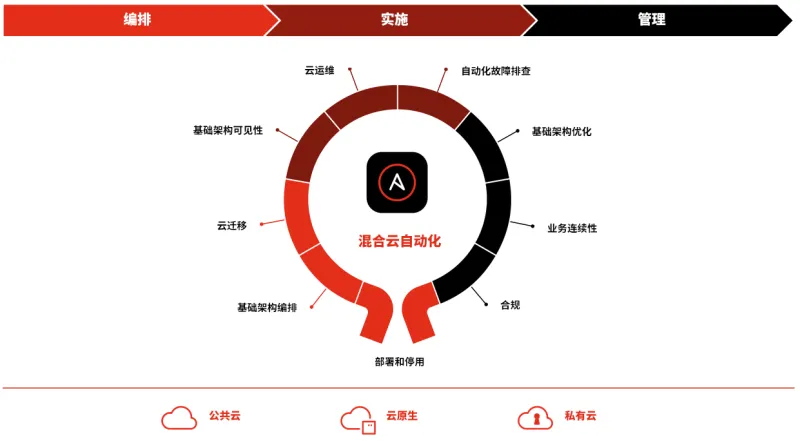
长话短说
在 AnsibleFest 2022 大会期间,红帽宣布了针对混合云的自动化计划。这是一项围绕产品展开的计划,旨在更好地支持公共云、私有云和云原生基础架构中的自动化用例。
Ansible 内容生态系统团队与红帽的合作伙伴携手开发了一套新的红帽 Ansible 认证内容集和 Ansible 验证内容,以解决多种最佳云技术的常见自动化用例。
现在,您可以使用 Ansible 验证内容来启动您的混合云自动化之旅,这为您提供了一个开箱即用、值得信赖的起点,您可以在此基础上学习、定制和培养自身技能。利用丰富且受支持的混合云内容基础,制定您的自动化策略。
大型企业正处于跨入云技术之旅的新阶段。无论是早期采用者还是初次接触云的 IT 部门,现在都能从多年的集体经验中获得丰富的信息、最佳实践和指导,采用更具战略意义的云运维方法。
总结过去 15 年我们所学到的经验,可以归纳为三点:
- 云不是一个单一的平台,而是一个通过数据和运维相互关联的技术组合。在尝试让这些技术和谐相融的过程中,混合云的概念得到了发展。
- 混合云的运维不光是工作负载的置备和停用。服务的生命周期要复杂得多,这种情况不仅会持续存在,还会因面临上述挑战而变得更加艰难。
- 混合云有望为大型企业提供或依靠的服务带来前所未有的灵活性和可访问性。但这也带来了规模、复杂性和速度方面的挑战,如果没有自动化的支持,运维人员将难以应对这些挑战。
您需要的各种平台
企业采用云消费模式的原因可能各不相同。有些原因是大多数行业共有的,而另一些则与各企业自身的市场和战略密切相关。如今,既采用公共云提供商(如 AWS、Microsoft Azure 和 Google Cloud),也采用私有云技术(如 OpenStack)和云原生平台(包括 红帽 OpenShift)的情况越来越普遍。
企业内的老员工都非常清楚,大型企业在采用新技术时,通常不会立即淘汰现有技术,而是会逐步过渡。新技术通常会被纳入企业产品组合,并随着时间的推移逐渐与其他系统和基础架构进行集成。因此,我们一直致力于提供基础坚实的红帽 Ansible 认证内容集,以支持集成所有领先的云技术,并且我们正在利用红帽 Ansible 自动化平台全面的服务和功能,实现跨企业基础架构的横向互操作性。
混合云全生命周期
尽管提升置备和停用流程的简易性和可靠性仍然至关重要,但这只占到混合云运维的一小部分。红帽及其合作伙伴进行了垂直投资,为云工作负载和服务的整个生命周期提供支持,从而全程为客户提供支持和服务,具体可分为三个阶段:
- 编排:涉及到部署、迁移和最终停用云资源,更为重要的是将它们相互连接起来,并通过统一的框架进行一致的运维。
- 实施:涉及到通过上述框架从混合云环境中收集信息,将自身流程转化为自动化工作流,并利用二者来支持自动化故障排查等复杂用例。
- 治理:涉及到将第一阶段中获得的覆盖面与第二阶段中获得的可见性和运维相结合,以支持更高级别的用例,从而优化并实现服务的业务连续性和合规性。
自动化技术具备乘数效应
多年来,事实证明,自动化是一项重要的基础技术,有助于应对公共云所带来的规模、复杂性和速度方面的挑战,这些挑战如今已遍及所有 IT 领域。在选择自动化技术时,应考虑三个关键点:
- 能否编排数千个端点,无论端点位于何处或属于哪家供应商。
- 能否通过一系列步骤简化复杂的架构,定义易于共享和自定义的可重复且可审计的工作流。
- 是否有工具来降低您所关注用例的采用门槛和扩展门槛,有助于推动您的自动化计划。
无论您处于自动化之旅的哪个阶段,Ansible 自动化平台的混合云自动化计划都能为您带来:
- 指导:由主题专家提供指导,介绍如何通过红帽 Ansible 认证内容更好地使用特定平台。
- 方法:通过 Ansible 验证内容,有针对性地指导您应该首先处理哪些基本用例。
- 能力:能够使用红帽 Ansible 认证内容和验证内容作为构建块,在混合云基础架构的不同部分之间进行互操作,同时使用 Ansible 自动化平台作为基础,帮助克服规模、复杂性和速度方面的挑战。
更重要的是,这些功能要通过易读且易懂的 Ansible 语言来交付。采用混合云自动化可以提供学习的机会,使您的企业能够节省时间和资金,并从可信的基础开始构建自己的混合云专业知识。
想要了解更多信息?以下是一些有用的链接:
- 阅读这本电子书,了解混合云自动化的价值:《大规模实现混合云自动化:连接云、团队和工作流》
- 访问 Ansible 混合云自动化网站
- 观看演示和概述视频,其中阐述和展示了 Ansible 混合云自动化的实际应用:YouTube 上的 Ansible 云自动化播放列表
- 通过自定进度实验室,自行试用 Ansible 自动化平台
关于作者
Massimo Ferrari is Management Strategy Director at Red Hat, responsible for developing strategic product direction for Ansible Automation Platform as well as fostering its partner ecosystem.
Prior to Red Hat, Ferrari worked as an industry analyst and consultant for over a decade, helping global organizations, including Fortune 1000 and Fortune Global 2000 companies. He has directed numerous international projects, from infrastructure assessment to product and partner selection.
Ferrari has held different IT management roles throughout his career and has expertise in architecting and managing complex IT projects, including datacenter consolidation through virtualization technologies, organization-wide security assessments and private and hybrid cloud projects. He is based in London.
